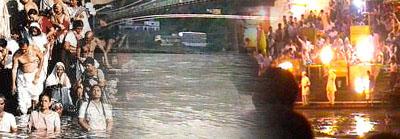
|
|
Introduction
It is not only in Hinduism that water has been treated as an object of reverence. Water has been considered pious not only in Hindu scriptures but in Holy Bible (Genesis 1:1-20), Quran (Sura-21.30 & 25.54). In Bible bathing in "Live (flowing) water" is referred to as ritual bath. Live water is one that flows down from the hills (river). In Mahabharata, XIII.27.48.52, Ganga water is treated at par with elixir of Gods. In Skand Puran V.1(ii).62.53, Ganga water is referred to be endowed with characteristics of Ambrosia. It is also believed that river Ganga has taken birth from the water pitcher of Lord Brahma. Ganga is supposed to be the archetype of sacred water. Ganga is the symbol of fertility and has purifying powers.
In Padmapuran Ganga is eulogised as a
river of salvation; "Swarga Moksha Pradaganaga". In Brahma
Puran, bathing in the waters of the confluence of Ganga and Yamuna
(especially in the month of Magh) gives the bather, punya (benefit)
of one thousand
Ashwamedha Yajna (Vedic sacrifice of horses). As per Mahabharata, Ganga
is equated with Rigveda, Yamuna with Yajurveda and Saraswati with
Atharveda. Any river of the world has no equal to Ganga. Lingpuran
compares the piousness of Ganga jal (water) with never wilting tulsi
patra. In Mahabharata, XIII.27.48-52, Ganga has been compared
with amrit (ambrosia or elixir) ; "as amrita is to God, Ganga
water is to men".
Suuferman and Morris in 1963 supported the above view after finding that Ganga water abounds in cynophage and bacteriophase that protects its water from pollution and decomposition.
It is Bharat's most sacred river that
is considered to wash all the sins or the effects of bad deeds and
is known also as Surasarita (the stream of Gods), Bhagirathi, Jahnavi
etc. Coming out of the Gomukha cavity of the snowy glacier Gangotri,
in Himalaya, and playing with the mountain peaks it enters on the
plain at Haridwar and sanctifying Uttar Pradesh, Bihar and Bengal
with its holy flow reaches and meets the ocean the portion of which
is known as Gangasagara (because of the event ). According to the
NadiSukta of the Rgveda, Ganga is the very first and foremost of the
rivers of Bharat. On the banks of Ganga are situated many well known
places of pilgrimage such as Haridwar, Prayag and Kashi. On its banks,
from the very beginning of time many of the Rishis, Munis and Tapasvis
have been performing their spiritual endeavours.
The water of Ganga is an object of comparison for purity and
unsulliness. This has been fully established through scientific experiments
that its capacity to get cleaned automatically is the highest among
the waters drawn from all other world sources. Hindus consider
this river to be the Mother and address it as Ganga maiya i.e.
Mother (Goddess) Ganga. According to its account in the Purana, Ganga
having had its start from the feet of Visnu entered in the Kamandalu
(water carrier) of Brahma, descending from where it had been retained
by Shiva in His matted hairs rolled up over His head and from there
king Bhagirath, of the Sagar dynasty, brought it to earth with a view
to bring salvation to his ancestors. In the Bhagavata Purana the story
of the descent of Ganga has been told in a detailed manner. According
to the Aditya Purana the descent of Ganga on earth took place on the
third day of the brighter fortnight of the month of Vaisakha and its
exit from Himalaya occured on the tenth day of the brighter fortnight
of the month of Jyestha (falling in the month of May). That day is
celebrated as the festival of Ganga Dasahara by having dip in Ganga
by millions of people.